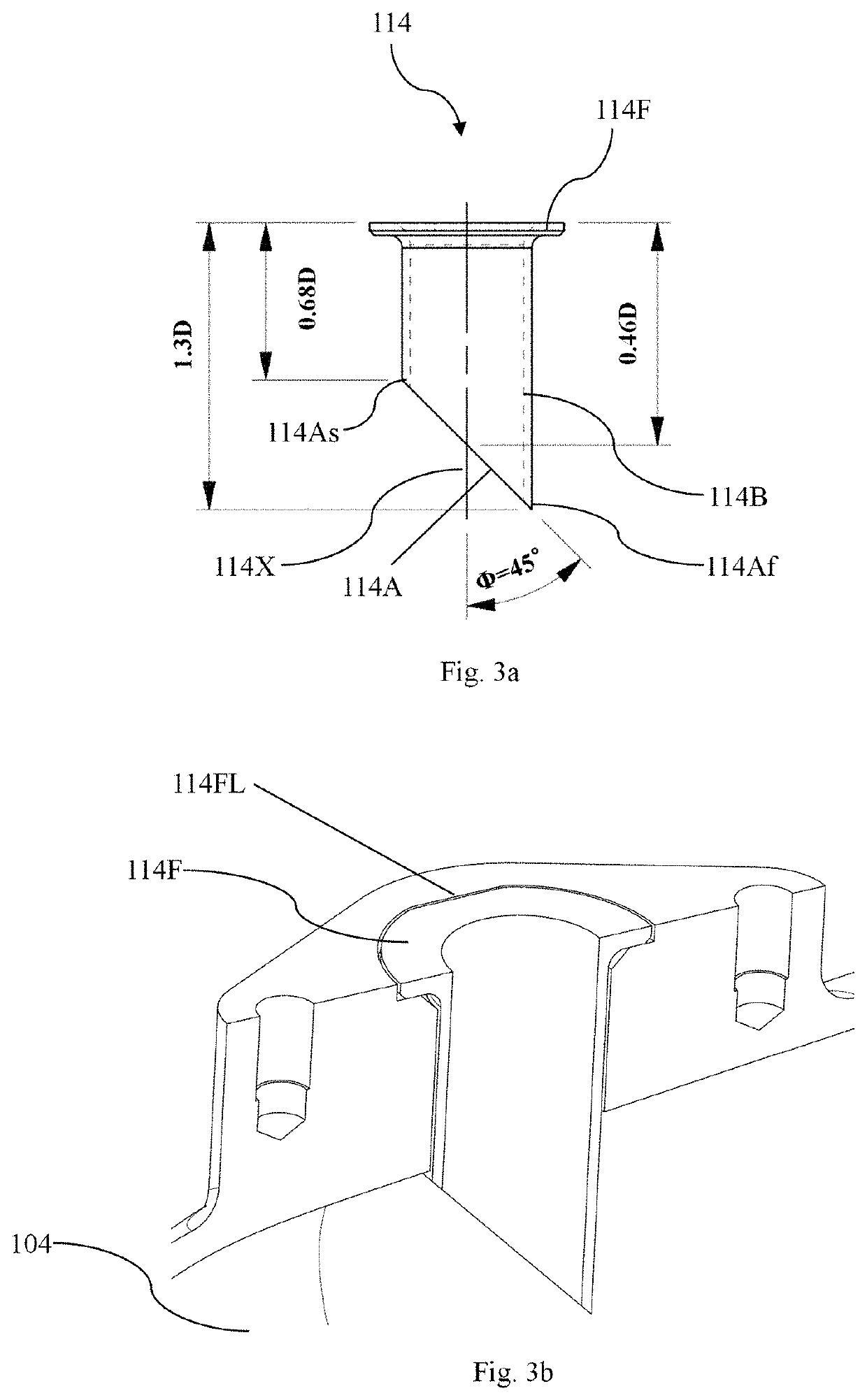Naturally aspirated common rail diesel engine meeting ultra low PM emission by passive exhaust after treatment
a common rail diesel engine and passive exhaust technology, which is applied in the direction of machines/engines, electrical control, separation processes, etc., can solve the problems of slowing down the chemical reaction of the combustion process, reducing the maximum combustion temperature within the cylinder, and undesirable presence of the latter gaseous stream in the produ
- Summary
- Abstract
- Description
- Claims
- Application Information
AI Technical Summary
Benefits of technology
Problems solved by technology
Method used
Image
Examples
first embodiment
[0039]FIGS. 2a and 2b depict cross sectional views of an air intake conduit (104) and an exhaust gas mixing conduit (114) in assembled condition, as disclosed herein. The exhaust gas mixing conduit (114) receives exhaust gas from the exhaust gas recirculation cooler (115) through the exhaust gas recirculation valve (110). One end of the exhaust gas mixing conduit (114) is coupled to the exhaust gas recirculation valve (110) and the other end of the exhaust gas mixing conduit (114) is connected to the air intake conduit (104). The exhaust gas mixing conduit (114) is adapted to facilitate uniform mixing of exhaust gas with fresh air in the air intake conduit (104). For example, the exhaust gas mixing conduit (114) is adapted to introduce the exhaust gas at center of the air intake conduit (104) for uniform mixing of exhaust gas with fresh air in the air intake conduit (104). The exhaust gas mixing conduit (114) includes a body (114B) and a flange (114F). At least a portion of the bod...
second embodiment
[0052]In the second embodiment, the exhaust gas mixing conduit (214) includes an angular fluid outlet (214A, as shown in FIG. 6) adapted to dispense the mixed fluid from the exhaust gas mixing conduit (214) to the air intake conduit (204), where the angular fluid outlet (214A) is provided at the end of the body (214B), One end (214Af) of the angular exhaust gas outlet (214A) is disposed away from another end (214As) of the angular fluid outlet (214A). In an embodiment, the exhaust gas mixing conduit (214) is being cut at a predefined angle with respect to a central axis (214X, as shown in FIG. 6) of the exhaust gas mixing conduit (214) therein to form the angular fluid outlet (214A). For example, the exhaust gas mixing conduit (214) is being cut at 45 degree with respect to the central axis (214X) of the exhaust gas mixing conduit (214) therein to form the angular fluid outlet (214A). However, it is also within the scope of this invention to cut the exhaust gas mixing conduit (214) ...
third embodiment
[0063]In the third embodiment, the exhaust gas mixing conduit (314) is disposed concentrically onto the air intake venturi conduit (304), where a longitudinal axis of the exhaust gas mixing conduit (314) is coaxial to a longitudinal axis of the air intake venturi conduit (304). The exhaust gas mixing conduit (314) is a tubular member concentrically disposed onto the air intake venturi conduit (314). The exhaust gas mixing conduit (314) includes an exhaust gas inlet (3141, as shown in FIG. 10) adapted to facilitate entry of exhaust gas from the exhaust gas recirculation (EGR) valve (110) to the exhaust gas mixing conduit (314). The diameter of exhaust gas inlet (3141) of the exhaust gas mixing conduit (314) is half the inner diameter (D) of the air intake venturi conduit (314). It is also within the scope of this invention to provide the diameter of exhaust gas inlet (3141) of the exhaust gas mixing conduit (314) in any other number. An inner diameter of the exhaust gas mixing condui...
PUM
| Property | Measurement | Unit |
|---|---|---|
| diameter | aaaaa | aaaaa |
| inner diameter | aaaaa | aaaaa |
| temperature | aaaaa | aaaaa |
Abstract
Description
Claims
Application Information
 Login to View More
Login to View More - R&D
- Intellectual Property
- Life Sciences
- Materials
- Tech Scout
- Unparalleled Data Quality
- Higher Quality Content
- 60% Fewer Hallucinations
Browse by: Latest US Patents, China's latest patents, Technical Efficacy Thesaurus, Application Domain, Technology Topic, Popular Technical Reports.
© 2025 PatSnap. All rights reserved.Legal|Privacy policy|Modern Slavery Act Transparency Statement|Sitemap|About US| Contact US: help@patsnap.com



